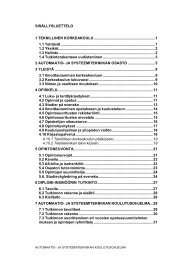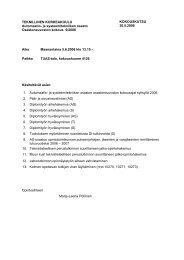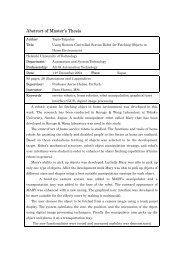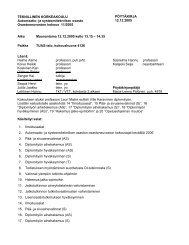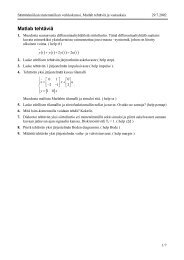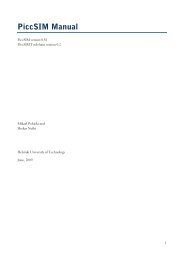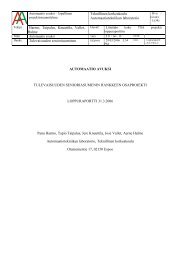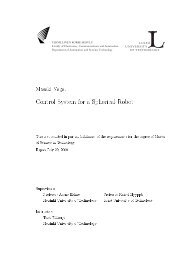fem modelling of a bellows and a bellows- based micromanipulator
fem modelling of a bellows and a bellows- based micromanipulator
fem modelling of a bellows and a bellows- based micromanipulator
You also want an ePaper? Increase the reach of your titles
YUMPU automatically turns print PDFs into web optimized ePapers that Google loves.
FEM <strong>modelling</strong> <strong>of</strong> a <strong>bellows</strong> <strong>and</strong> a <strong>bellows</strong>-<strong>based</strong> <strong>micromanipulator</strong>I. IntroductionCompared to the real manipulator, the model is simplified to check only the tripod-like<strong>bellows</strong> structure – not the piezoactuators – where one end <strong>of</strong> the <strong>bellows</strong> are fixed. One <strong>of</strong>the first simulation was performed in ADAMS 1 by Mikael Lind [Lind98], using beams toassume the <strong>bellows</strong>. It shows that their bending should not cause any insuperable problems incontrolling the movement <strong>of</strong> the manipulator. But the created models can’t be used as exactkinematic model, because the used beam statement doesn’t take into account that diffractionline <strong>of</strong> the beam is actually curved, <strong>and</strong> it's not known exactly how good the approximation <strong>of</strong>the <strong>bellows</strong> as elastic beams is. In practice, the non-linear pressure differences inside the<strong>bellows</strong> will cause some variations during the motion.That’s the reason why a more accurate model using finite elements method should be usedto simulate the <strong>bellows</strong> behaviour under distinct situations, <strong>and</strong> under different pressures. Theparameters that will arise from that simulation should be used in the kinematic model <strong>of</strong> the<strong>micromanipulator</strong>, to perform an accurate open-loop control.1.2 Finite Element Method1.2.1 FEMThe finite element method (FEM) was developed more by engineers using physical insightthan by mathematicians using abstract methods. Its first application was in stress analysis, butwas since applied to other problems, as temperature flux, electronics <strong>and</strong> fluidics. In our case,it will be used structural analysis.A naive way to describe the FE method is that it involves cutting a structure into severalelements – kinds <strong>of</strong> little pieces <strong>of</strong> the whole structure – describing the behaviour <strong>of</strong> eachelement in a simple way, <strong>and</strong> then, reconnecting elements together by their corners, the socalled“nodes”, as if they were pins or drops <strong>of</strong> glue that hold elements together. This processresults in a set <strong>of</strong> simultaneous algebraic equations. In stress analysis, these equations areequilibrium equations <strong>of</strong> the nodes. It means that at each node, the addition <strong>of</strong> all forcesapplied on it should be equal to zero. This may generate hundreds or thous<strong>and</strong>s <strong>of</strong> suchequations, which means that computer implementation is compulsory.In all applications, the analyst seeks to calculate a field quantity. In stress analysis, it is thedisplacement field or the stress field; in thermal analysis it is the temperature field or the heatflux – which is also a field. In fluidics, it is the stream function or the velocity potentialfunction, <strong>and</strong> so on. Usually, the interest lies in peak values <strong>of</strong> either the field quantity or itsgradients. The FEM is a way to get a numerical solution to a specific problem. A FE analysisdoes not produce a formula as a solution, nor does it solve general problems. Also, thesolution is only an approximation since the way to get it is numerical.A more involved description <strong>of</strong> the FEM considers it as piecewise polynomial interpolation.That is, over an element, a field quantity such as displacement is interpolated from values <strong>of</strong>the field quantity at nodes. By connecting elements together, the field quantity becomesinterpolated over the entire structure in piecewise fashion, by as many polynomial expressionsas there are elements.The best values <strong>of</strong> the field quantity at nodes are those that minimise some function such asthe total energy contained in the stress. The minimisation process generates a set <strong>of</strong>simultaneous algebraic equations for values <strong>of</strong> the field quantity at the nodes.1 ADAMS is a world-wide used simulation <strong>and</strong> <strong>modelling</strong> s<strong>of</strong>tware, especially for mechanical systems.3



